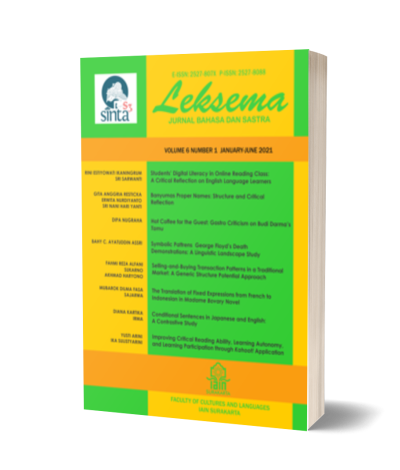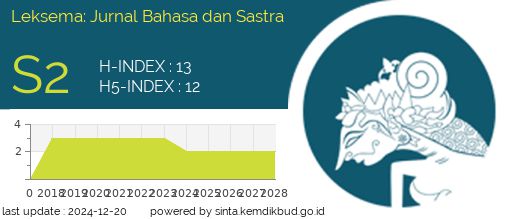POST-EDITING PROPORTION OF GOOGLE TRANSLATE IN INFORMATIVE AND EXPRESSIVE TEXTS
DOI:
https://doi.org/10.22515/ljbs.v4i1.1558Keywords:
Google translate, translation evaluation, informative text, expressive textAbstract
The massive development of Google Translate (GT) is remarkable and there are many people all over the world use it. Yet, the texts that have been translated by GT still need post-editing by the human translator. This research aims to find the proportion that translator needed in post-editing when using GT in translating of informative and expressive text from English to Indonesia and what they need to pay attention in translating informative and expressive text using GT. The data in this research were words, phrases, and sentences that were analyzed using descriptive-comparative with error analysis at three different levels: accuracy and acceptability. The result shows that the proportion of post-editing for informative text is 5% for accuracy and 22% for acceptability, while in the expressive text, 33% for accuracy and 47% for acceptability. Humans need more effort in post-editing the expressive text because the structure of the sentences in the expressive text is more complex and longer. Furthermore, there are many CSI (Cultural Specific Items) found in the expressive text that makes the result unacceptable for TT readers. Another problem in using GT that the result of GT translation is literal while the expressive text has many of figurative meaning. It means that GT is acceptable for semantic translation. Thus, this research suggests GT can be used directly in translating informative text because informative, as long as the users conduct post-editing and the users should not use GT in translating expressive text directly except for decoding the semantic, pragmatic, and contextual meaning to find the suitable translation.Downloads
References
Ali, HIH, & SMS Al-Rushaidi, 2016. "Translating Idiomatic Expressions from English into Arabic: Difficulties and Strategies". Arab World English Journal (AWEJ), 7(4):187–201.
Halimah. 2018. Error Analysis in English-Indonesian Machine Translation. In Proceeding of 1st International Seminar on Innovation and Development of Education of Asia. July 14th, 2018: 29-36
Halley, MC. 1980. "Concrete Abstraction: The Linguistic Universe of Metaphors". In MKL. Ching, MC. Halley & FR. Lonsford (Eds.). Linguistic Perspective on Literature. London: Routledge & Kegan Paul Ltd.
Halliday, MAK, & R. Hasan. 1976. Cohesion in English. New York: Longman.
Henrique, Arruda D, LF. Costa & DR. Ammancio, 2017. "Using Complex Networks for Text Classification: Discrimanting Informative and Imaginative Documents". Journal of English Language Teaching, 12 (2): 2
Huang, HJ. 2011. "Intermediality and Human vs Machine Translation". Comparative Literature and Culture, 13 (3): 1-11. Retrieved at
Ismail, A & R.Hartono. 2016. "Errors Made in Google Translate In the Indonesian to English Translation of Newes Item Texts". Journal of English Language Teaching, 5 (2): 1–6
Jaganathan, P, M. Hamzah & I. Subramaniam, (2014). "An Analysis of Google Translate Use in Decoding Contextual Semanticity among EFL Learners". Asian Journal of Research in Social Sciences and Humanities, 4 (9): 1-13. Retrieved at <https://doi.org/ 10.5958/2249-7315.2014.00962.9>
Koponen, M. 2010. "Assessing Machine Translation Quality with Error Analysis". In Electronic Proceedings of the KäTu Symposium on Translation and Interpreting Studies Translation and Interpreting Studies, 4: 1–12
Lakoff, G, & M. Johnson. 2003. Metaphors We Live By. Chicago: University of Chicago Press.
Larson, ML. 1984. Meaning Based-Translation. Boston: University Press of America
Medvedev, G. 2016. Google Translate in Teaching English. Journal of Teaching English for Specific and Academic Purposes, 4 (1): 181-193
Munday, J. 2016. Introducing Translation Studies: Theories and Applications (4th ed.). New York: Routledge.
Napitupulu, S. 2017. "Analyzing Indonesian-English Abstract Translation in View of Translation Errors by Google Translate". International Journal of English Language and Linguistics Research, 5 (2): 15-23
Newmark, P. 1988. A Textbook of Translation. Englewood Cliffs: Prentice-Hall International.
Nirmala, D. 2011. Metaphors: Universal, Specific, and Public. Bahasa dan Seni, 39 (2): 250-265.
Putri, GD & Ardi, H. 2015. "Types of Errors Found in Google Translation: A Model of MT Evaluation". In Proceeding Third International Seminar on English Language and Teaching (ISELT-3): 183-188).
Robinson, D. 2001. Becoming A Translator: An Accelerated Course. London: Routledge
Sahin, M & Dungan, N. 2014. "Translation Testing and Evaluation : A Study on Methods and Needs". The International Journal for Translation & Interpreting Research, 6 (2): 67-90. Retrieved at https://doi.org/ti.106202. 2014.a05/Abstract
Vidhayasai, T, S.Keyuravong & T. Bunsom, 2015. "Investigating the Use of Google Translate in Terms and Conditions" in an Airline's Official Website : Errors and Implications". PASAA, 49: 137-169
Downloads
Published
Issue
Section
License
The copyright of the received article shall be assigned to the publisher of the journal. The intended copyright includes the right to publish the article in various forms (including reprints). The journal maintains the publishing rights to published articles.
In line with the license, the authors and users (readers or other researchers) are allowed to share and adapt the material only for non-commercial purposes. In addition, the material must be given appropriate credit, provided with a link to the license, and indicated if changes were made. If authors remix, transform or build upon the material, authors must distribute their contributions under the same license as the original.






